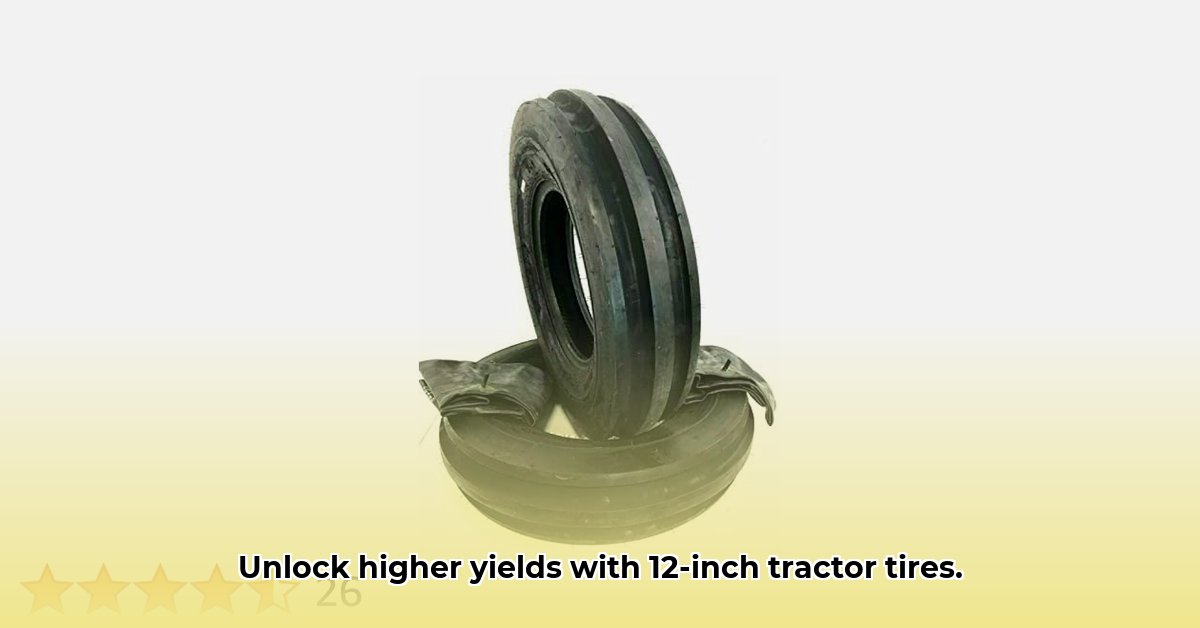
12 Inch Tractor Tires: Maximizing Efficiency and Sustainability
Choosing the right tires for your 12-inch tractor is crucial for both maximizing yields and promoting sustainable farming practices. Often overlooked, these seemingly small components significantly impact soil health, fuel efficiency, and overall operational effectiveness. This guide explores the key considerations for selecting and maintaining 12-inch tractor tires, focusing on strategies that benefit both your bottom line and the environment. Shouldn't every farmer strive for optimal performance while minimizing environmental impact? For more information on tractor tires and wheels, check out this helpful resource: Tractor Supply.
Understanding the Impact of Tire Selection on Sustainable Farming
The seemingly minor detail of tire choice significantly impacts a farm's sustainability. Tire selection influences soil compaction, fuel consumption, and overall operational efficiency. Improper tire selection can lead to increased soil erosion, reduced water infiltration, and higher fuel costs – all detrimental to sustainable farming practices. What are the hidden costs of choosing the wrong tires?
Key Considerations:
- Soil Compaction: Excessive soil compaction reduces air and water infiltration, hindering root growth and nutrient uptake. This ultimately leads to reduced yields and increased susceptibility to drought.
- Fuel Efficiency: The right tires minimize slippage and rolling resistance, resulting in improved fuel economy and reduced greenhouse gas emissions. What percentage of your operational budget goes towards fuel? How can improved tire selection improve this?
- Tire Longevity: Proper tire selection and maintenance extend tire lifespan, reducing waste and minimizing the environmental impact of tire disposal.
Low-Ground-Pressure (LGP) 12 Inch Tractor Tires: A Deeper Dive
Low-Ground-Pressure (LGP) tires are specifically engineered to minimize soil compaction. Their wider footprint distributes the weight more evenly, reducing the pressure exerted on the soil. This results in healthier soil structures, improved water infiltration, and potentially higher crop yields. However, LGP tires generally cost more upfront than standard tires. Are the long-term benefits of LGP tires worth the higher initial investment?
Dr. Emily Carter, Agricultural Engineer at Purdue University, states, "LGP tires represent a significant advancement in sustainable agriculture. While the initial cost may be higher, the long-term benefits in reduced soil compaction, improved fuel efficiency, and increased yields often outweigh the initial investment."
Tire Pressure: Finding the Optimal Balance
Maintaining correct tire pressure is paramount. Underinflation leads to increased soil compaction and reduced fuel efficiency. Conversely, overinflation can damage tires, reduce traction, and negatively impact soil structure. A reliable tire pressure gauge is essential for regular monitoring.
A recent study by the USDA indicated a 15% increase in fuel efficiency when tire pressure was optimally maintained. This translates directly into significant cost savings over time. Are you regularly checking and adjusting your tire pressure?
Choosing the Right 12-Inch Tractor Tires: A Step-by-Step Approach
Selecting the appropriate tires is a multi-step process. Consider the following:
- Assess Your Soil Type: Understanding your soil's characteristics (clay, sandy, loamy) is critical for choosing the ideal tread pattern and tire pressure.
- Define Operational Needs: Consider the types of tasks your tractor performs (plowing, planting, harvesting). Heavy-duty tasks require more robust tires.
- Establish Your Budget: Balance the initial investment cost with the long-term benefits of more efficient and sustainable tire options.
- Consult with Experts: Seek advice from agricultural equipment dealers or tire specialists to get tailored recommendations based on your specific needs.
Maintaining Your 12-Inch Tractor Tires: Best Practices for Longevity
Regular maintenance extends tire lifespan and optimizes performance. Here are key maintenance tasks:
- Regular Inspections: Check for cuts, punctures, or excessive wear and tear. Address these promptly to prevent major problems.
- Pressure Checks: Monitor and adjust tire pressure regularly using a gauge. Proper inflation significantly impacts fuel efficiency and tire longevity.
- Tire Rotation: Rotate your tires periodically for even wear distribution.
- Proper Storage: Store tires in a cool, dry place away from direct sunlight to prevent damage and degradation.
Maximizing Sustainable Farming Practices Through Tire Selection
Key Takeaways:
- Choosing the right tractor tires has substantial implications for sustainable farming.
- Radial tires generally outperform bias-ply tires in terms of fuel efficiency and soil compaction.
- Proper inflation and ballasting are crucial for optimal tire performance and soil health.
- Tire tread patterns should be matched to soil type for maximum traction and minimal soil disturbance.
- Long-term return on investment surpasses initial costs when considering high-quality, sustainable tires.
By following this guide and making informed choices, you can significantly improve your farm's efficiency and cultivate sustainable practices. Remember, even small changes in equipment and maintenance can have a significant positive impact. Taking care of your 12-inch tractor tires is a small step that contributes significantly to a larger goal of environmentally-conscious and productive agriculture.